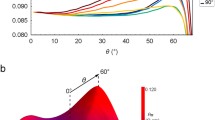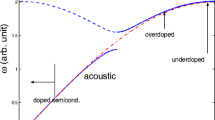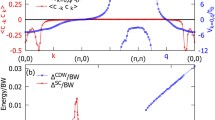Abstract
The Fermi surface—the set of points in momentum space describing gapless electronic excitations—is a central concept in the theory of metals. In this context, the normal ‘metallic’ state of the optimally doped high-temperature superconductors is not very unusual: above the superconducting transition temperature, Tc, there is evidence for a large Fermi surface1,2,3, despite the absence of well-defined elementary excitations. In contrast, the normal state of underdoped high-temperature superconductors differs in that there is evidence for a ‘pseudogap’ above Tc (4–7). Here we examine, using angle-resolved photoemission spectroscopy, the temperature dependence of the Fermi surface in underdoped Bi2Sr2CaCu2O8+δ. We find that, on cooling the sample, the pseudogap opens up at different temperatures for different points in momentum space. This leads to an initial breakup of the Fermi surface, at a temperature T*, into disconnected arcs, which then shrink with decreasing temperature before collapsing to the point nodes of the superconducting ground state below Tc. This unusual behaviour, where the Fermi surface does not form a continuous contour in momentum space as in conventional metals, is unprecedented in that it occurs in the absence of long-range order. Moreover, although the superconducting gap below Tc evolves smoothly into the pseudogap above Tc, the pseudogap differs in its unusual temperature-dependent anisotropy, implying an intimate but non-trivial relationship between the pseudogap and the superconducting gap.





Similar content being viewed by others
References
Campuzano, J. C. et al. The Fermi surfaces of YBa2Cu3O6.9 as seen by angle-resolved photoemission. Phys. Rev. Lett. 64, 2308–2312 (1990).
Olson, C. G. et al. High-resolution angle-resolved photoemission study of the Fermi surface and normal-state electronic structure of Bi2Sr2CaCu2O8. Phys. Rev. B 42, 381–386 (1990).
Randeria, M. et al. Momentum distribution sum rule for angle-resolved photoemission. Phys. Rev. Lett. 74, 4951–4954 (1995).
Marshall, D. S. et al. Unconventional electronic structure evolution with hole doping in Bi2Sr2CaCu2O8+δ: angle-resolved photoemission results. Phys. Rev. Lett. 76, 4841–4844 (1996).
Ding, H. et al. Spectroscopic evidence for a pseudogap in the normal state of underdoped high-Tc superconductors. Nature 382, 51–54 (1996).
Loeser, A. G. et al. Excitation gap in the normal state of underdoped Bi2Sr2CaCu2O8+δ. Science 273, 325–329 (1996).
Ding, H. et al. Evolution of the Fermi surface with carrier concentration in Bi2Sr2CaCu2O8+δ. Phys. Rev. Lett. 78, 2628–2631 (1997).
Uemura, Y. J. et al. Universal correlations between Tc and ns/m* in high-Tc cuprate superconductors. Phys. Rev. Lett. 62, 2317–2320 (1989).
Lee, P. A. in High Temperature Superconductivity (eds Bedell, K. S. et al.) 96–116 (Addison-Wesley, New York, (1990)).
Engelbrecht, J. R., Nazarenko, A., Randeria, M. & Dagotto, E. Pseudogap above Tc in a model with d x 2 − y 2 pairing.Preprint available at http://xxx.lanl.gov/archive/cond-mat/9705166
Wen, X. G. & Lee, P. A. Theory of underdoped cuprates. Phys. Rev. Lett. 76, 503–506 (1996).
Ding, H. et al. Angle-resolved photoemission spectroscopy study of the superconducting gap anisotropy of Bi2Sr2CaCu2O8+x. Phys. Rev. B 54, R9678–B9681 (1996).
Acknowledgements
We thank J. Sadleir and A. Kaminski for their help. This work was supported by the US Dept of Energy Basic Energy Sciences, the US NSF, the NSF Science and Technology Center for Superconductivity, the CREST of JST, and the Ministry of Education, Science and Culture of Japan. The Synchrotron Radiation Center is supported by the NSF.
Author information
Authors and Affiliations
Corresponding author
Rights and permissions
About this article
Cite this article
Norman, M., Ding, H., Randeria, M. et al. Destruction of the Fermi surface in underdoped high-Tc superconductors. Nature 392, 157–160 (1998). https://doi.org/10.1038/32366
Received:
Accepted:
Issue Date:
DOI: https://doi.org/10.1038/32366
- Springer Nature Limited
This article is cited by
-
Unconventional surface state pairs in a high-symmetry lattice with anti-ferromagnetic band-folding
Communications Physics (2023)
-
Unveiling phase diagram of the lightly doped high-Tc cuprate superconductors with disorder removed
Nature Communications (2023)
-
Property alteration of (Bi,Pb)-2212 superconductors added with graphene oxide nanoparticles
Journal of Materials Science: Materials in Electronics (2023)
-
Angle-resolved photoemission spectroscopy
Nature Reviews Methods Primers (2022)
-
Emergence of Fermi arcs due to magnetic splitting in an antiferromagnet
Nature (2022)





